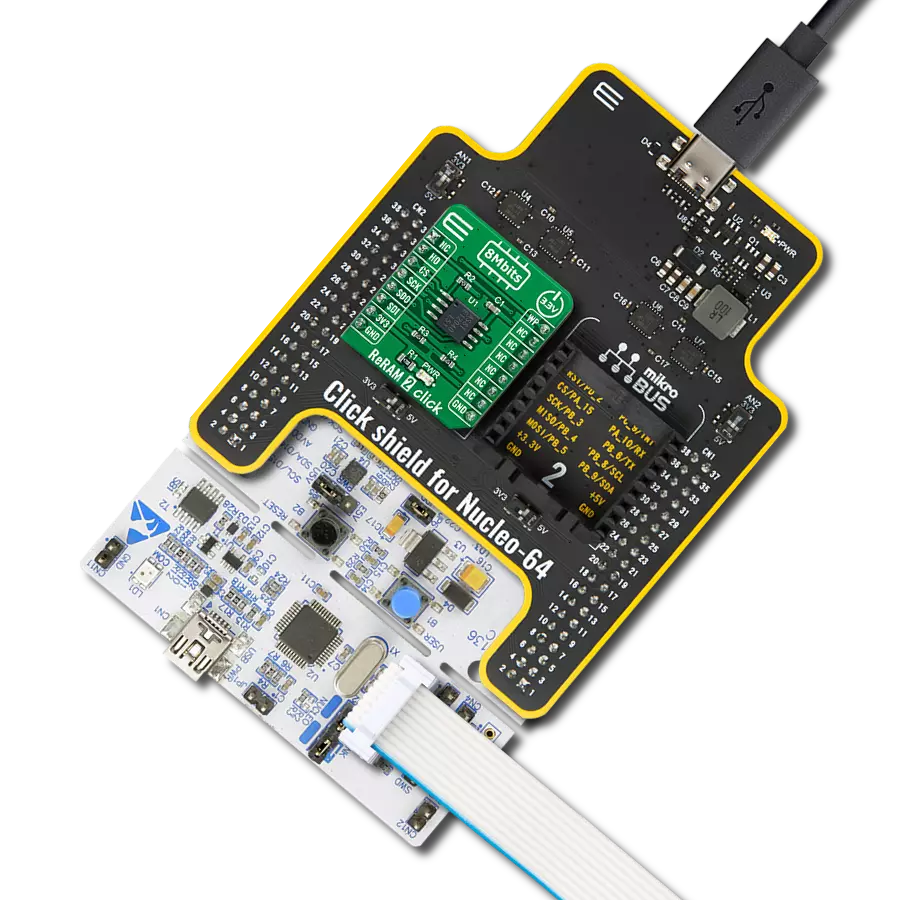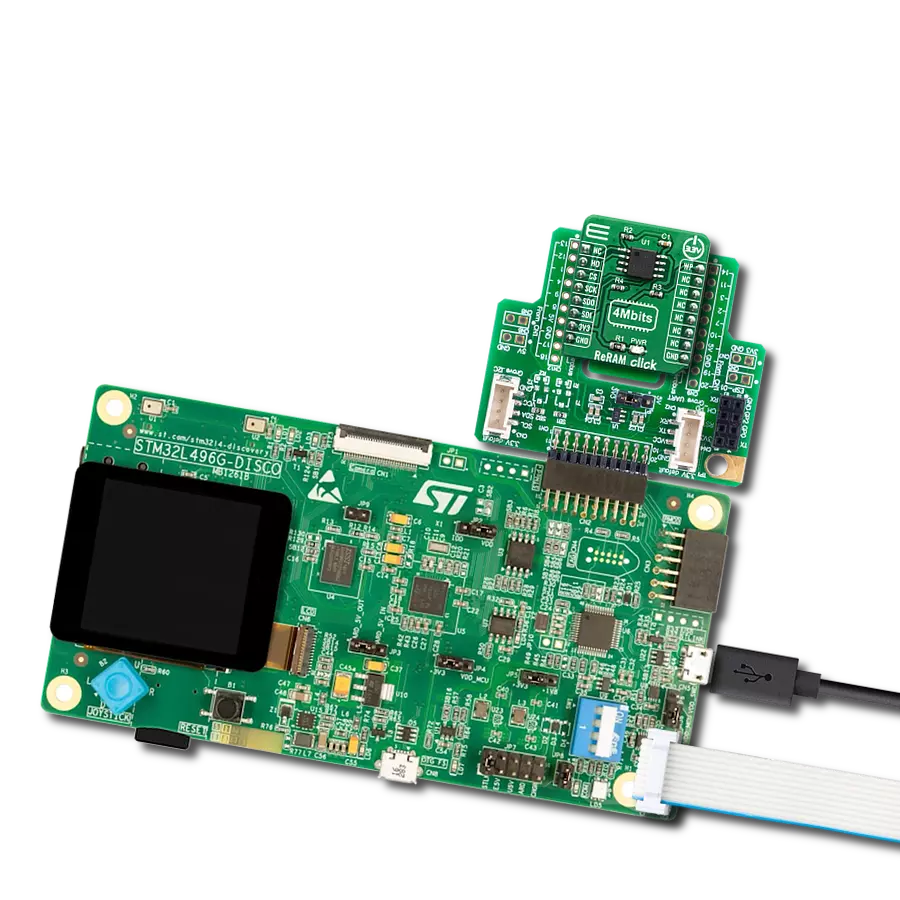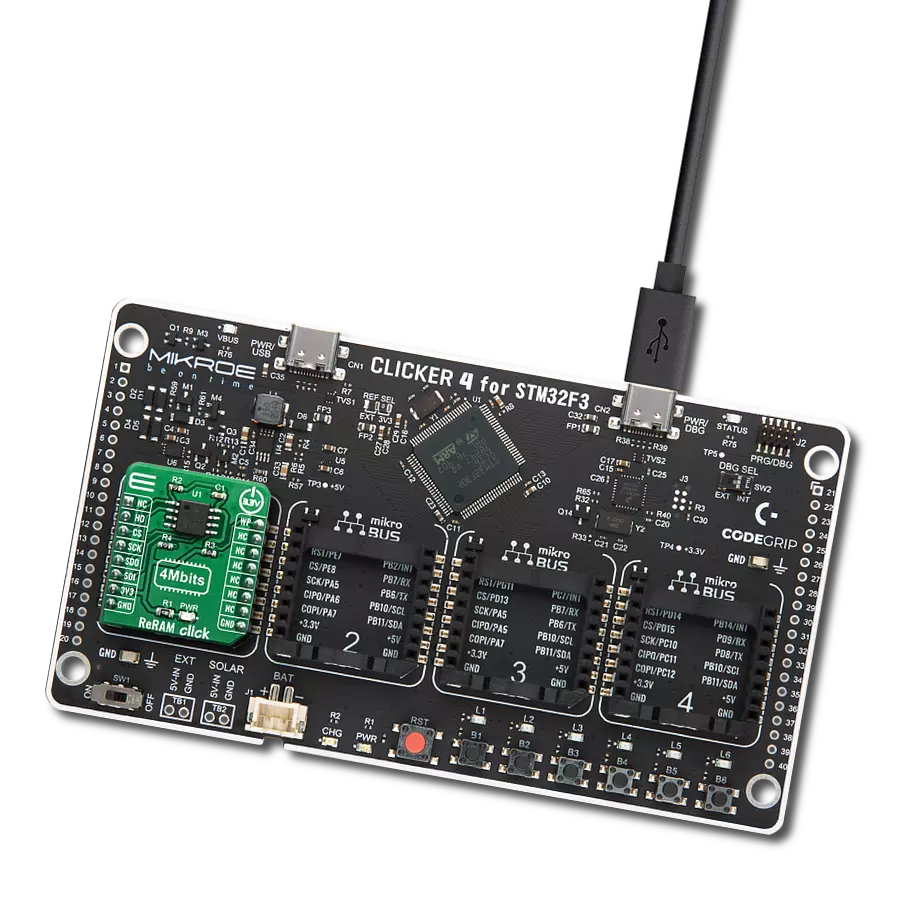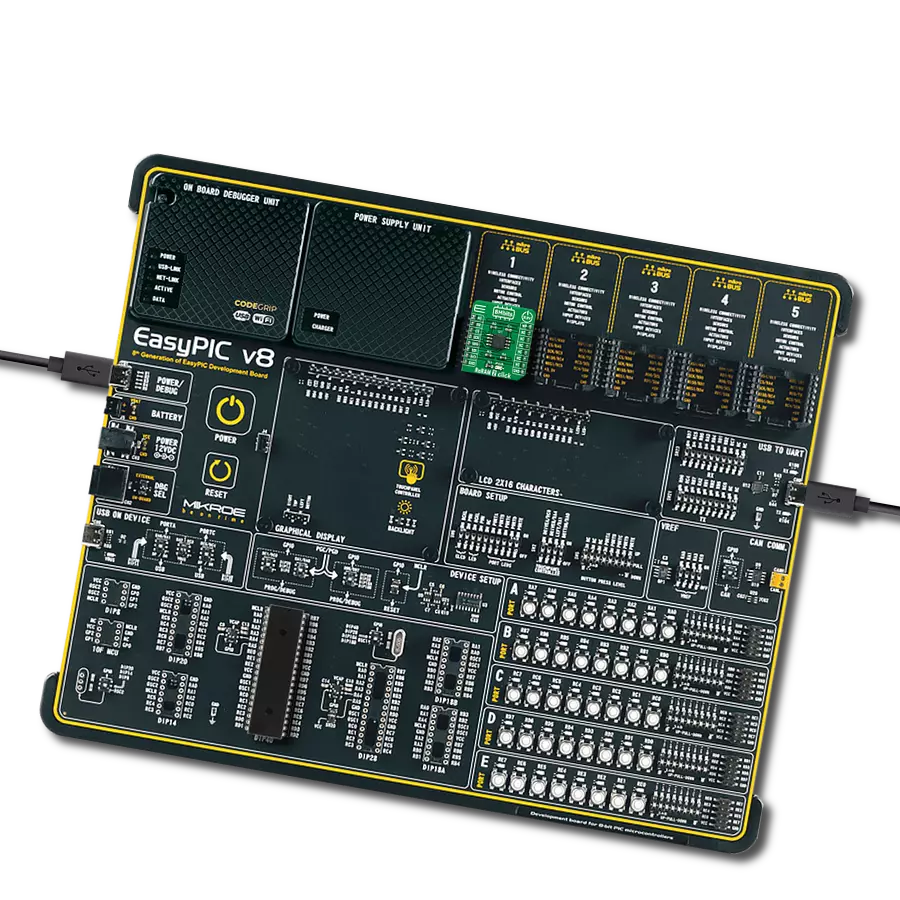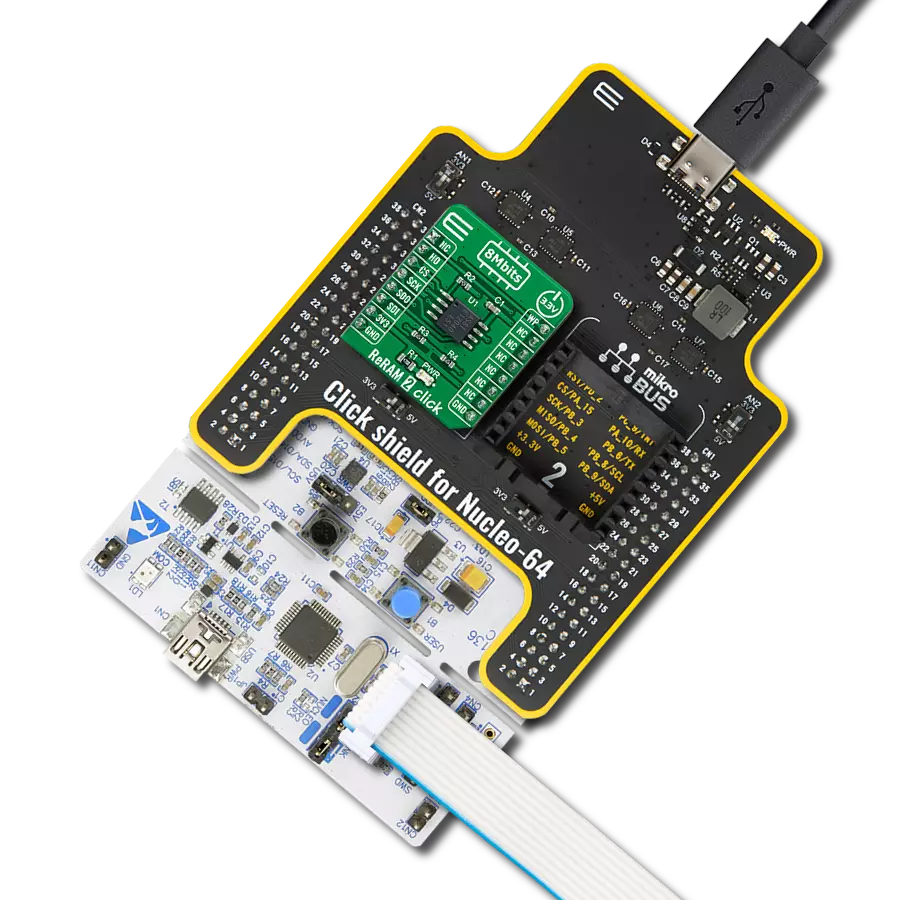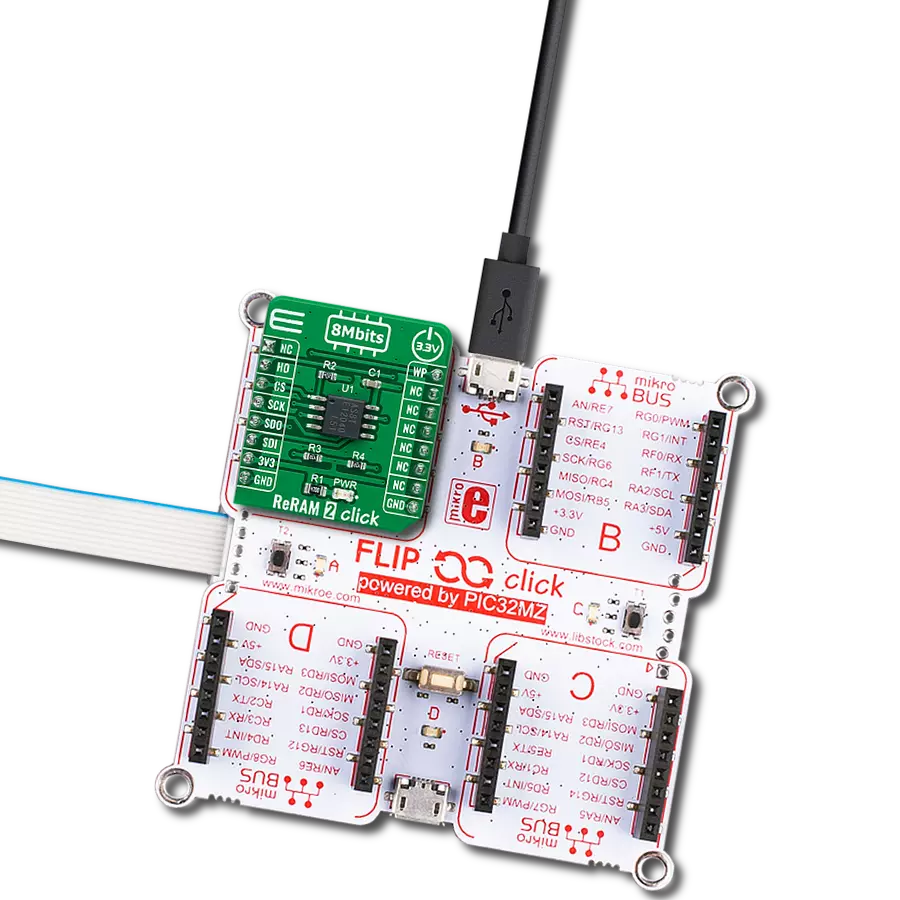Enhance your data storage capabilities with ReRAM, the innovative solution that's redefining how we store and access information
A
A
Hardware Overview
How does it work?
ReRAM 2 Click is based on the MB85AS8MT, a highly reliable 8Mbit resistive random-access memory (ReRAM) organized as 1,048,576 words of 8 bits from Fujitsu Semiconductor. It uses the resistance-variable memory process and silicon-gate CMOS process technologies to form nonvolatile memory cells. The MB85AS8MT specifies 1.000.000 endurance cycles with data retention of a minimum of 10 years, which gives the MB85AS8MT the capability to handle unlimited reads/writes to the memory. One prominent feature of the MB85AS8MT is an extremely small average current, despite its large density, for reading operations of 0.15mA at an operating frequency of 5MHz, which is only 5% of
large-density EEPROM devices. This feature enables minimal power consumption when in applications with frequent data-read operations. Besides higher write endurance, it has faster write speeds than EEPROM and flash memory, while its electric specifications, such as commands and timings, are compatible with EEPROM products. The ReRAM 2 Click communicates with MCU through a standard SPI interface that enables high clock speeds up to 10MHz, supporting the two most common SPI modes, SPI Mode 0 and 3. An additional feature of this Click board™ represents the configurable Write Protection function labeled as WP routed on the PWM pin of the mikroBUS™ socket. The WP pin protects the entire memory
and all registers from write operations and must be set to a low logic state to inhibit all the write operations. All memory and register write are prohibited when this pin is low, and the address counter is not incremented. Besides, the ReRAM 2 Click also has an additional HOLD pin, routed to the RST pin of the mikroBUS™ socket labeled as HO, to interrupt a serial operation without aborting it. This Click board™ can be operated only with a 3.3V logic voltage level. The board must perform appropriate logic voltage level conversion before using MCUs with different logic levels. Also, it comes equipped with a library containing functions and an example code that can be used as a reference for further development.
Features overview
Development board
PIC18F57Q43 Curiosity Nano evaluation kit is a cutting-edge hardware platform designed to evaluate microcontrollers within the PIC18-Q43 family. Central to its design is the inclusion of the powerful PIC18F57Q43 microcontroller (MCU), offering advanced functionalities and robust performance. Key features of this evaluation kit include a yellow user LED and a responsive
mechanical user switch, providing seamless interaction and testing. The provision for a 32.768kHz crystal footprint ensures precision timing capabilities. With an onboard debugger boasting a green power and status LED, programming and debugging become intuitive and efficient. Further enhancing its utility is the Virtual serial port (CDC) and a debug GPIO channel (DGI
GPIO), offering extensive connectivity options. Powered via USB, this kit boasts an adjustable target voltage feature facilitated by the MIC5353 LDO regulator, ensuring stable operation with an output voltage ranging from 1.8V to 5.1V, with a maximum output current of 500mA, subject to ambient temperature and voltage constraints.
Microcontroller Overview
MCU Card / MCU

Architecture
PIC
MCU Memory (KB)
128
Silicon Vendor
Microchip
Pin count
48
RAM (Bytes)
8196
You complete me!
Accessories
Curiosity Nano Base for Click boards is a versatile hardware extension platform created to streamline the integration between Curiosity Nano kits and extension boards, tailored explicitly for the mikroBUS™-standardized Click boards and Xplained Pro extension boards. This innovative base board (shield) offers seamless connectivity and expansion possibilities, simplifying experimentation and development. Key features include USB power compatibility from the Curiosity Nano kit, alongside an alternative external power input option for enhanced flexibility. The onboard Li-Ion/LiPo charger and management circuit ensure smooth operation for battery-powered applications, simplifying usage and management. Moreover, the base incorporates a fixed 3.3V PSU dedicated to target and mikroBUS™ power rails, alongside a fixed 5.0V boost converter catering to 5V power rails of mikroBUS™ sockets, providing stable power delivery for various connected devices.
Used MCU Pins
mikroBUS™ mapper
Take a closer look
Click board™ Schematic

Step by step
Project assembly
Software Support
Library Description
This library contains API for ReRAM 2 Click driver.
Key functions:
reram2_read_device_id- ReRAM 2 read device ID function.reram2_write_memory- ReRAM 2 write memory function.reram2_read_memory- ReRAM 2 read memory function.
Open Source
Code example
The complete application code and a ready-to-use project are available through the NECTO Studio Package Manager for direct installation in the NECTO Studio. The application code can also be found on the MIKROE GitHub account.
/*!
* @file main.c
* @brief ReRAM2 Click example
*
* # Description
* This library contains API for ReRAM 2 Click driver.
*
* The demo application is composed of two sections :
*
* ## Application Init
* Initializes SPI driver and log UART.
* After driver initialization the app set default settings,
* performs device wake-up, check Device ID,
* set Write Enable Latch command and write demo_data string ( mikroE ),
* starting from the selected memory_addr ( 1234 ).
*
* ## Application Task
* This is an example that demonstrates the use of the ReRAM 2 Click board™.
* In this example, we read and display a data string, which we have previously written to memory,
* starting from the selected memory_addr ( 1234 ).
* Results are being sent to the Usart Terminal where you can track their changes.
*
* @author Nenad Filipovic
*
*/
#include "board.h"
#include "log.h"
#include "reram2.h"
static reram2_t reram2;
static log_t logger;
static char demo_data[ 9 ] = { 'm', 'i', 'k', 'r', 'o', 'E', 13 ,10 , 0 };
static uint32_t memory_addr;
void application_init ( void )
{
log_cfg_t log_cfg; /**< Logger config object. */
reram2_cfg_t reram2_cfg; /**< Click config object. */
/**
* Logger initialization.
* Default baud rate: 115200
* Default log level: LOG_LEVEL_DEBUG
* @note If USB_UART_RX and USB_UART_TX
* are defined as HAL_PIN_NC, you will
* need to define them manually for log to work.
* See @b LOG_MAP_USB_UART macro definition for detailed explanation.
*/
LOG_MAP_USB_UART( log_cfg );
log_init( &logger, &log_cfg );
log_info( &logger, " Application Init " );
// Click initialization.
reram2_cfg_setup( &reram2_cfg );
RERAM2_MAP_MIKROBUS( reram2_cfg, MIKROBUS_1 );
if ( SPI_MASTER_ERROR == reram2_init( &reram2, &reram2_cfg ) )
{
log_error( &logger, " Communication init." );
for ( ; ; );
}
if ( RERAM2_ERROR == reram2_default_cfg ( &reram2 ) )
{
log_error( &logger, " Default configuration." );
for ( ; ; );
}
reram2_wake_up( &reram2 );
Delay_ms ( 100 );
if ( RERAM2_ERROR == reram2_check_device_id( &reram2 ) )
{
log_error( &logger, " Communication Error. " );
log_info( &logger, " Please, run program again... " );
for( ; ; );
}
reram2_send_command( &reram2, RERAM2_CMD_WREN );
Delay_ms ( 100 );
log_info( &logger, " Application Task " );
memory_addr = 1234;
log_printf( &logger, "\r\n Write data : %s", demo_data );
reram2_write_memory( &reram2, memory_addr, &demo_data[ 0 ], 9 );
log_printf( &logger, "-----------------------\r\n" );
Delay_ms ( 1000 );
}
void application_task ( void )
{
static char rx_data[ 9 ] = { 0 };
reram2_read_memory( &reram2, memory_addr, &rx_data[ 0 ], 9 );
log_printf( &logger, " Read data : %s", rx_data );
log_printf( &logger, "-----------------------\r\n" );
Delay_ms ( 1000 );
Delay_ms ( 1000 );
}
int main ( void )
{
/* Do not remove this line or clock might not be set correctly. */
#ifdef PREINIT_SUPPORTED
preinit();
#endif
application_init( );
for ( ; ; )
{
application_task( );
}
return 0;
}
// ------------------------------------------------------------------------ END
Additional Support
Resources
Category:ReRAM






















